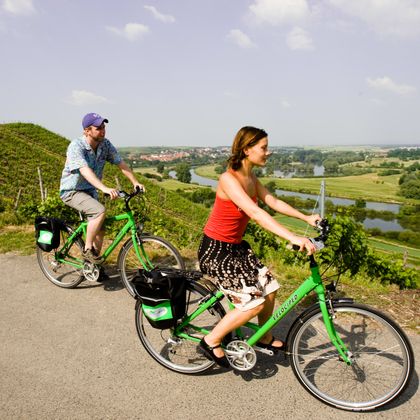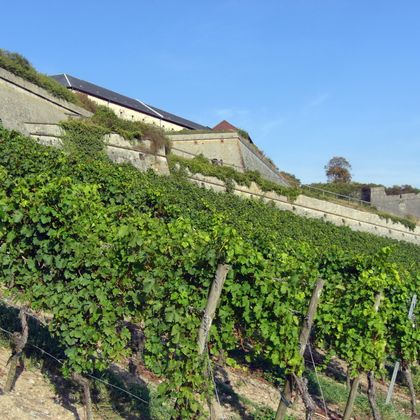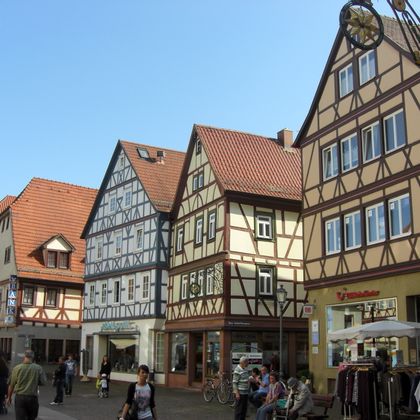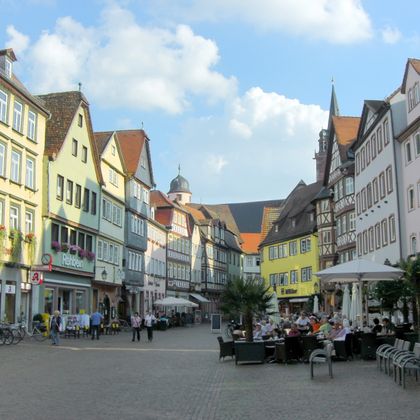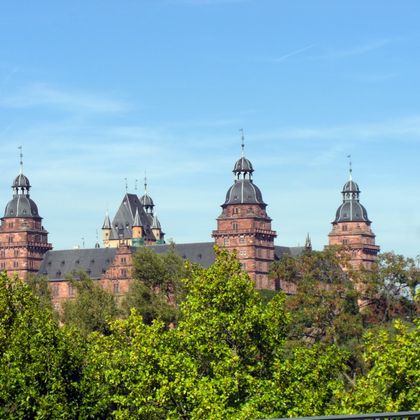Tour
Arrive in time to visit Bayreuth with the margrave’s residence still revealing the charm of the past and famous in the whole world for the Richard-Wagner-festival.
Follow the young Red Main to Kulmbach today! Let the cozy atmosphere of this charming Franconian landscape at the confluence of the Red and the White Main and at the foot of the Frankenwald and the Fichtelgebirge captivate you. Visit the Old-town of Kulmbach and Plassenburg castle, enthroned majestically above the town. Now as red and white have flown together, you will actually move on by the side of the “real” Main in order to reach soon the pretty town of Burgkunstadt inviting for a short stop. And then, finally, todays final destination lies just ahead of you: Lichtenfels, famous for its basket-weaving art far past the limits of Franconia. Here, a short side trip to the baroque pilgrimage basilica Vierzehnheiligen, constructed by the famous architect Balthasar Neumann, is absolutely recommendable!
Let’s begin the day with a short visit of Banz monastery. Along the route to Bamberg, you will see how the Main River is ponded in small lakes several times. You will find your hotel in the center of Bamberg. Benefit from this closeness and cycle into the Old-town, classified world cultural heritage by the UNESCO.
Follow the Regnitz for a short moment until you reach the Main River, taking you now to the beautiful pilgrimage church Maria Limbach. You will soon reach the first vineyards marking the border between the beer-brewing and the wine-growing areas of Franconia. Enjoy a sunny day in Haßfurt where another historical Old-town will impress you. A short side-trip to Theres is recommendable today: After a nice break there, you will continue along the edge of the Main to Schweinfurt. Discover the vestiges of the ancient imperial town and walk on the footprints of the industrial pioneers and discoverers and let the modern Schweinfurt treat you!
Passing numerous vineyards, you will cycle through the small, historic wine-growing town Wipfeld, home of the "Zehntgraf". Take a relaxing break here and marvel at the precious old buildings of the town and its idyllic situation. In the afternoon, you will cross Fahr, town of the Bocksbeutel (the local wine is sold in this unique kind of container), to reach Volkach, famous for its excellent wines!
Leaving Volkach behind, you will follow the Main-channel before catching up to the Main River again in Schwarzach. Via the even and well-paved bike trail, you will reach Würzburg quickly and have enough time to discover the town individually.
Past Veitshöchheim with the prince-bishop’s summer residence and the French rococo garden, you will continue to Karlstadt and its worthwhile town centre. Along the route you will witness how the landscape changes from the characteristic vineyards into wide, green forests providing shade on the bike trail. Even paths take you to Gemünden, where three rivers meet.
The wooded hills seem to cuddle up closer, leaving just enough space for the Main to wind itself through. Past the small town of Rothenfels, whose castle seems to watch over the valley attentively, you will reach Marktheidenfed and Wertheim. The gracious half-timbered houses and the Old-town’s maze of narrow streets will fascinate you!
You will reach Miltenberg around noon. The town presents itself with pride: Let the half-timbered style architecture and the market place amaze you. On even bike trails, you will quickly reach the sandstone-built Johannisburg castle of Aschaffenburg after passing the Spessart and the Odenwald.
Spend your lunch break in the romantic small town Seligenstadt, whose winding alleys and friendly half-timbered houses almost urge you to stay. Hanau is not less worthwhile: Steinheim castle, the German House of Goldsmiths and the castle of Philippsruhe are absolute highlights. Just like Offenbach, which is 1000 years old, where you will stay your night. Do not miss out on the Renaissance façade of Isenburg castle. Bed and breakfast in Offenbach.
It is up to you to decide how much time you wish to spend in Frankfurt on the Main. Be aware, that today’s destination, Mainz, also has a lot to offer. Cycling and culture will complement each other very well today. Bed and breakfast in Mainz.
After breakfast your nice cycle holiday ends in Mainz near the main station. Departure is possible by German railway.
Map
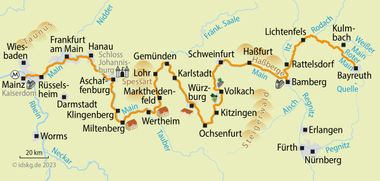
Prices / Dates
Services / Info
-
- Overnight stay with breakfast:
Category A: Comfortable middle-class hotels, mostly in the center
Category B: partly family-run inns and smaller hotels - room with D/bath/WC
- luggage transport
- Cycling map with marked route
- Digital route guidance via smartphone app
- Tips for trip preparation
- Tourist information
- 7-day hotline service
- Overnight stay with breakfast:
Worth knowing about the bike tour Main: the very long tour
Below you will find specific and helpful information. If you have further questions about this trip, you simply call us: Phone: +49 (0)6421 – 886890.
Arrival by train
Bayreuth is easily accessible from all major cities in Germany by train. We recommend to take a taxi from the station to get to our partner hotels in Bayreuth. Current schedule information and price information can be found at: www.bahn.de.
Parking facilities at the arrival location
Our partner hotels in Bayreuth always provide parking (subject to a fee) possibilities for the entire duration of your bike trip. There are always plenty of parking spots available, no pre-reservation is necessary. Detailed information on parking at your hotel, you will receive together with the detailed travel documents two weeks prior to departure.
Condition of cycle paths
As Germany's first bike route the Main bike trail got awarded with five stars by ADFC in 2008. Important criteria for this award were the almost universal asphalting and the nearly traffic-free routes. The specially signposted cycle track runs mostly every time directly at the Main riverside and is without significant gradients.
Transfer back to the starting point of the journey
The return journey to Bayreuth is exclusively on your own by train. There are connections every two hours (1-3 changes, duration approx. 3 3/4 to 5 hours). You can find more information on the Internet at www.bahn.de.
Extra costs which are not included in the tour price
A possible tourist tax and charging fees for bicycle batteries are also not included in the tour price and must therefore be paid at the hotel on site.
7 day hotline service
Just in case the bike chain breaks, flooding makes it impossible to continue your tour or any other nasty surprise: You can reach us seven days a week and we will do anything to help you as fast as possible.
Passport and visa requirements
For EU citizens, there are no special passport or visa requirements and no health formalities to be considered for this trip.
Travel insurance
The tour price already includes the statutory insolvency insurance. In addition, we recommend that you take out travel cancellation insurance upon receipt of your travel confirmation in order to protect yourself against financial disadvantages in the event of travel cancellation, interruption of travel, illness or accident.
For all those who want to combine comfort with sustainability and only require digital travel documents, we grant a discount of € 20.00 per room.
Please let us know at the time of booking whether you would like to use printed or digital travel documents.
Available rental bikes
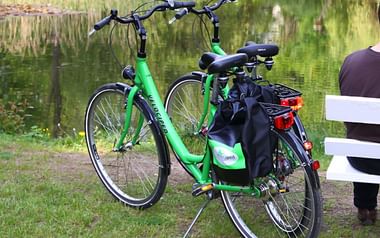
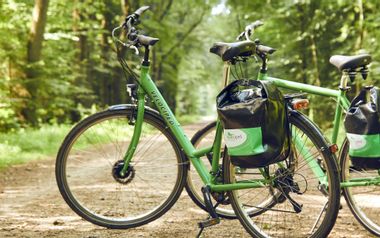
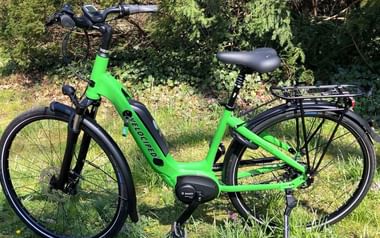


We would recommend the 7-speed tourer for all those that are looking for a back-pedal brake and wide gel seat for maximum comfort in an upright sitting position. It is equipped with a simple hub gear shift and is perfectly suited to tours on flat to slightly hilly terrain.

The 27-speed tourer is the best choice for cyclists that value the advantages of the dérailleur gear shift for flexibility whilst going up and down hills. This bike allows you to be a little more active without compromising on saddle comfort and practical everyday suitability.

E-bikes combine a lot of advantages. The electric drive ensures a completely relaxed cycling, even during long tours or on hilly routes. Other features, such as a suspension seat post and front fork plus well-tuned gears, ensure additional riding comfort.

On this trip, you can choose between e-bikes with a back-pedal brake or a freewheel. The e-bikes with a freewheel also offer you excellent riding comfort with a suspension seat post and front fork. Please simply indicate your preference when booking.

I provide you with advice and assistance
Miriam Houda
